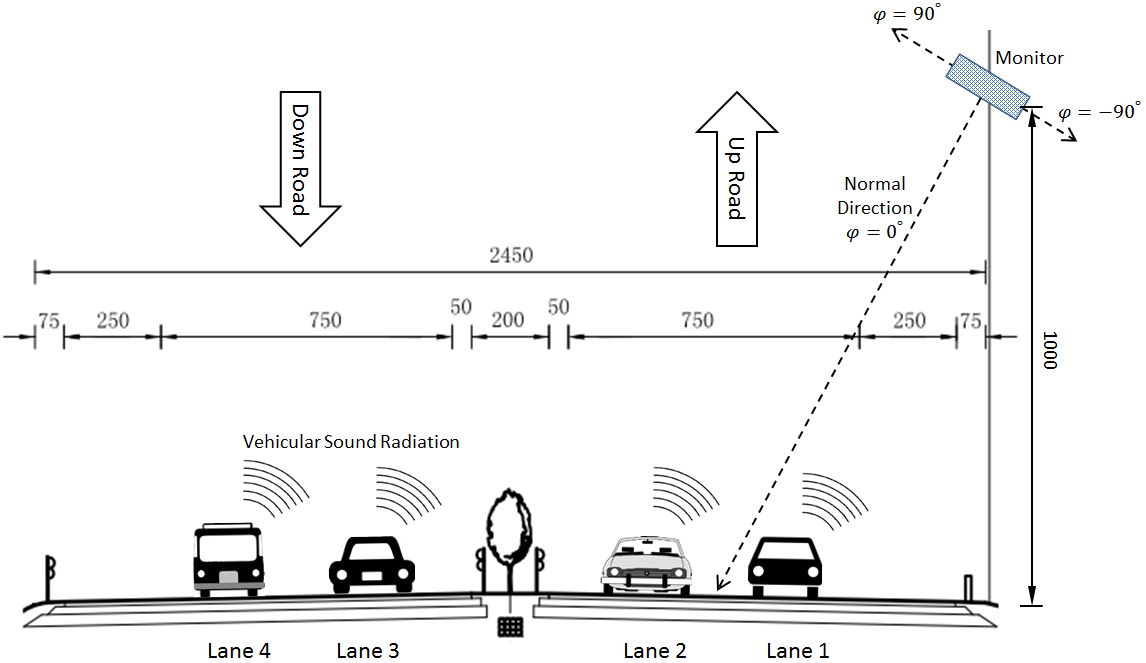Vehicles emit sounds as they travel along the road, which can be captured by a road-side device and used as a kind of feature for traffic monitoring. Compared with other traffic monitoring techniques, acoustic based approach is more robust against light and weather variations, and has lower hardware cost (Fig. 1). In addition, acoustic sensor (microphone) is relatively inexpensive than other traffic monitoring sensors like camera and radar.

Fig. 1 Demonstrations of acoustic traffic monitoring. The lengths are in centimeters, and the lane width is 375 cm (Image by IOA).
Researchers NA Yueyue, GUO Yanmeng, FU Qiang and YAN Yonghong from the Institute of Acoustics (IOA) of the Chinese Academy of Sciences recently introduce an acoustic-based lane detection approach of cross array and rank-1 Multiple Signal Classification (MUSIC) algorithm for a multilane traffic monitoring system. This system can achieve high highway lane detection resolution with low computational complexity.
To capture road-side vehicular sounds and perform beamforming, a microphone array is needed. The requirement is that the array should have small aperture size for easy installation. Meanwhile, the angular resolution should be high enough to distinguish vehicles in adjacent lanes. According to the typical Chinese highway structure in Fig. 1, a microphone array based on the cross array structure is designed.
In the following, the proposed lane detection approach comprises of two steps. In the first step, it forms a lane detection cross section, and detects the azimuths of passing vehicles. Next, it utilizes azimuth statistics to find lane centers and widths.
The MUSIC algorithm is a famous source localization algorithm, which can be used here to detect vehicle direction-of-arrivals. Although this algorithm has high resolution, the corresponding computational complexity is also high since the eigenvalue decomposition is required to estimate the signal and noise subspaces, which are used for direction-of-arrival estimation.
However, for highway environment, there is a great chance that the lane detection cross section is occupied by only a single vehicle at a time when the traffic is not congested. This single source assumption can be used to simplify the classical MUSIC algorithm to its rank-1 version for the problem. The new algorithm has the same angular resolution but lower complexity, since the eigenvalue decomposition is not required.
Fig.2 compares the lane detection results in the simulated environment of Fig. 1.Due to the lack of resolution, the classical delay-and-sum approach detects the furthest two lanes as one lane (the yellow peak) in Fig. 2 (a). On the other hand, in Fig. 2 (b), the proposed approach successfully detects all four lanes in the simulated environment.

(a) The delay-and-sum approach.

(b) The proposed approach.
Fig. 2 Lane detection results comparison (Image by IOA).
About the full system, these researchers have also completed another research of “An Acoustic Traffic Monitoring System: Design and Implementation” which had been edited as news released on IOA’s webpage last year in September. The system comprises of four main modules: microphone array, lane detection module, lane-wise vehicle monitoring module, and user interface. And the current research is about in-depth investigation of the system’s microphone array and lane detection module.
Reference:
NA Yueyue, GUO Yanmeng, FU Qiang, YAN Yonghong. Cross Array and Rank-1 MUSIC Algorithm for Acoustic Highway Lane Detection. IEEE Transactions on Intelligent Transportation Systems (Volume:PP, Issue: 99, March 2016, Pages 1-13). DOI: 10.1109/TITS.2016.2521661
Contact:
NA Yueyue
Key Laboratory of Speech Acoustics and Content Understanding, Institute of Acoustics, Chinese Academy of Sciences, 100190 Beijing, China
Email: nayueyue@hccl.ioa.ac.cn


